Space Vision 2004: Making Astronomy Accessible to Visually Impaired Students
Judit Györgyey Ries,
U. Texas at Austin/McDonald Observatory
M.R. Baguio, Texas Space Grant Constortium
T.D. Jurgens, Texas Space Grant Constortium
K.M. Pruett, Texas School for the Blind and Visually Impaired
Abstract

Astronomy, with good reason, is thought of as a visual science. Spectacular images of deep space objects or other worlds
of our solar system inspire public interest in Astronomy. People encounter news about the universe during their daily life.
Developing concepts about celestial objects presents an extra challenge of abstraction for people with visual impairments.
The Texas Space Grant Consortium with educators at the Texas School for the Blind and Visually Impaired have developed
a 2 day workshop to be held in April 2004 to help students with visual impairments understand these concepts. Hands-on
activities and experiments will emphasize non-visual senses. For example, students will learn about:
- Constellations as historical ways of finding one's way across the sky.
- The size and structure of the Solar System by building a scale model on a running track.
They will also:
- Plan a planetary exploration mission.
- Explore wave phenomenon using heat and sound waves.
In preparation for the workshop we worked with teens involved in the countywide 4-H Teens Leading with Character (TLC)
program to create the tactile materials necessary for the activities. The teens attended solar system education training so
they would have the skills necessary to make the tactile displays to be used during the workshop. The results and evaluation
of the workshop will be presented at the meeting.
Touch the Universe: A NASA Braille Book of Astronomy inspired this workshop, and it is supported by HST Grant HST-ED-90255.01-A.
Introduction
On April 23, 24 2004 nine middle and high school students attended a weekend Short Term Program in Austin at Texas School
for the Blind and Visually Impaired (TSBVI) to learn about space and astronomy. The goals for the class were:
Students will increase their understanding of concepts related to space and astronomy. They will experience scientific exploration through hands-on activities. They will also have opportunities to practice expanded core curriculum skills including: skills of independent living, orientation and mobility (O&M), use of technology, communication skills, recreation and leisure skills, visual efficiency and social skills.
In the student's local public schools they might not be aware of the tools available for the visually impaired but they learned about them here. For example, talking calculators tactile/visual handouts made from microencapsulated ("swell") paper to enable students to study illustrations. The concepts and skills were addressed in this program through a variety of activities utilizing tactile, kinesthetic, auditory and visual senses. The final agenda was organized around the following astronomy concepts:
- Constellation, Coordinate Systems, GPS navigation
- Lunar phases
- Solar System (Description, Kepler's laws, small bodies, formation)
- Nature of light (wave phenomena) and telescopes
- Exploring other worlds (Newton's Laws, rocket propulsion, scientific investigation)
The activities were conducted by Ries, Baguio, Jurgens, Pruett and Maylene Bird (TSBVI). Betty Schulz (TSBVI) assisted with food,
materials and helping students with individual needs, Jeremy Cheatham and Marlena Faulkner (TSBVI) were responsible for extra
residential activities.
Constellations
 Students were given a set of coordinates representing the brightest stars of a few familiar constellations without identifying them.
They used tactile graph boards to recreate the groupings, and were asked to guess how to connect the points, that is to make their
own constellations. Some students with vision recognized the patterns. In the case of Cygnus they came close to the usual
representation, but most of the time did not. Through this exercise they learned that the constellations are arbitrary forms,
though often based on mythology. These images aided our ancestors in remembering the sky, thus enabling them to observe
the motion of the planets, or use stars for navigation and telling time before maps and clocks became widely available.
Students were given a set of coordinates representing the brightest stars of a few familiar constellations without identifying them.
They used tactile graph boards to recreate the groupings, and were asked to guess how to connect the points, that is to make their
own constellations. Some students with vision recognized the patterns. In the case of Cygnus they came close to the usual
representation, but most of the time did not. Through this exercise they learned that the constellations are arbitrary forms,
though often based on mythology. These images aided our ancestors in remembering the sky, thus enabling them to observe
the motion of the planets, or use stars for navigation and telling time before maps and clocks became widely available.
GPS Scavenger Hunt
In order to put into practice what they learned about the coordinate systems, arranged a scavenger hunt on the school campus.
The school has one Braille Note GPS receiver. Other standard GPS units were on loan from University of Texas Aerospace Engineering.
The students' assignment was to locate objects with a space theme based on the coordinates provided. The last point of the hunt was
a table with their morning snacks. This activity provided an excellent opportunity to introduce them to measurement uncertainties,
since the readouts at the locations did not match perfectly the coordinates given, nor with the second readout they were asked to
make on the way back from the break. Using their own measurements, they were asked to convert the uncertainty into meters from
arcseconds.

Lunar Phases
 We used simple Styrofoam balls, each half painted in contrasting color with one colored half smooth and the other rough, for
tactile enhancement. The students were asked to describe what they see or feel as the relative positions of the Earth (student),
the Moon (ball) and the Sun (designated classroom wall) changed. They were instructed to keep the brightly painted side, the lit
hemisphere, always facing the Sun (wall). We discussed that while it represents the phases, it does not represent the actual
rotation of the Moon. We illustrated synchronous rotation by a student (Earth) and the instructor (Moon) facing each other
and holding outstretched hands. The instructor was led around the student keeping the relative position. Students observing
from the outside were asked what they saw, realizing that while the outsiders saw all sides of the Moon, meaning that it rotates,
the student holding the Moon could only see (or feel) one side.
We used simple Styrofoam balls, each half painted in contrasting color with one colored half smooth and the other rough, for
tactile enhancement. The students were asked to describe what they see or feel as the relative positions of the Earth (student),
the Moon (ball) and the Sun (designated classroom wall) changed. They were instructed to keep the brightly painted side, the lit
hemisphere, always facing the Sun (wall). We discussed that while it represents the phases, it does not represent the actual
rotation of the Moon. We illustrated synchronous rotation by a student (Earth) and the instructor (Moon) facing each other
and holding outstretched hands. The instructor was led around the student keeping the relative position. Students observing
from the outside were asked what they saw, realizing that while the outsiders saw all sides of the Moon, meaning that it rotates,
the student holding the Moon could only see (or feel) one side.
Rockets
We introduced the students to the idea of rocket propulsion using inflated toy balloons. Later they used plastic film canisters
and paper to construct light rockets. Alka Seltzer and water provided the propellant. This also served as a review of Newton's
laws of motion.

Exploring Other Worlds
 The students thoroughly enjoyed scientific exploration by discovering and analyzing a completely unfamiliar substance, that was
named "oobleck" after a green gooey substance in a Dr. Seuss book. The students needed to decide what to find out about this new,
strange kind of matter (corn starch, water and green food dye), how to find it out, and whether they could make predictions about
further observations from what they learned. During the star party they got interested in lunar craters, thus we improvised a
demonstration making craters in dry corn starch by dropping a light ball. So after exploring oobleck, they needed to make a
scientific prediction whether or not they could make a crater on a planet made of oobleck using the same method.
The students thoroughly enjoyed scientific exploration by discovering and analyzing a completely unfamiliar substance, that was
named "oobleck" after a green gooey substance in a Dr. Seuss book. The students needed to decide what to find out about this new,
strange kind of matter (corn starch, water and green food dye), how to find it out, and whether they could make predictions about
further observations from what they learned. During the star party they got interested in lunar craters, thus we improvised a
demonstration making craters in dry corn starch by dropping a light ball. So after exploring oobleck, they needed to make a
scientific prediction whether or not they could make a crater on a planet made of oobleck using the same method.
 Small Bodies of the Solar System
Small Bodies of the Solar System
Making an "authentic" comet complete with jets spewing was almost as much fun for the students as exploring oobleck. They were also able to touch and explore "out of this world" bodies. We had received on loan a small sample of meteorites from the Monnig Meteorite Collection, Fort Worth, Texas.

Solar System Formation
We asked the student to compare orbital properties like inclinations, rotational direction, and try to classify the planets based
on size, distance and density based on Internet search of their planets. The session on asteroids, comets and meteors acquainted
them with the small bodies still present today. Thus they were able to identify regularities that any reasonable formation theory has
to explain. An activity on the merry-go-round illustrated the conservation of angular momentum, a key element explaining the
coplanar planetary orbits.
Star Party
The group visited the 16 inch student telescope on the University of Texas campus. The weather cooperated and they were able to
view the crescent Venus. The crescent Moon and Venus were fairly close on the sky and unless somebody paid special attention,
they could not tell where the telescope was pointing. They viewed Venus at first, but nobody was told what it was. They were
instructed to look, try to figure out what they saw, but not to tell anybody. Everybody, even the accompanying adults, thought
they were looking at the Moon and were surprised, but pleased, to learn about the phases of Venus. This offered us feedback
that they were really able to see the planet. They also looked at the Moon, and many of the students were able to observe craters
at the terminator, asking what they are and how they formed. Before the weather deteriorated, they were also able to view another
area of the moon.

Using the telescope, all of the students, even those who were functionally blind, were able to visually experience these celestial
bodies as they never had before. Regardless of visual acuity, students expressed pleasure or awe at what they were able to see.
They were very excited about their viewing experience. For most of them, this was the highlight of the weekend.
Summary
 We have attempted to select activities that illustrate some basic concepts in Astronomy and provide base knowledge for further
studies. The activities can be carried out in regular classrooms. The changes we made were simply to enhance visual effects,
that is, to increase contrast and introduce tactile elements reinforcing the visual experience of handouts and props. This was
our first workshop, and we cut back on quantitative analysis by the student. However it was gratifying to notice that even during
these two short days most of the students went from random guessing of the answers to building on what they learned. Although
the students were able to absorb an amazing amount of new information, we feel we should have limited the number of activities
and do those more in depth, using a slightly more mathematical approach.
We have attempted to select activities that illustrate some basic concepts in Astronomy and provide base knowledge for further
studies. The activities can be carried out in regular classrooms. The changes we made were simply to enhance visual effects,
that is, to increase contrast and introduce tactile elements reinforcing the visual experience of handouts and props. This was
our first workshop, and we cut back on quantitative analysis by the student. However it was gratifying to notice that even during
these two short days most of the students went from random guessing of the answers to building on what they learned. Although
the students were able to absorb an amazing amount of new information, we feel we should have limited the number of activities
and do those more in depth, using a slightly more mathematical approach.
The student evaluations were all very positive, and we were encouraged that all participants expressed interest in a follow-up
workshop, and if possible, a longer course. All of them were happy to have been given the opportunity to look or even just to touch
a telescope. Working with these young people was also very educational for us, who usually do not have much contact with them.
By the end of the workshop we all forgot that they were "impaired".
We found nothing Earth-shattering: as we expected, visually impaired students can be just as fascinated by space as anybody
else, and given the opportunity are eager to learn. This can be done with just a little bit of extra effort in regular schools too,
if the teachers are prepared. By not being able to rely heavily on visual aids, the presenters also needed to be more clear and
better organized about what to say, and anybody can benefit from that.
Teachers from the TSBVI knew that these students can be taught, but did not know what to teach. We knew what we wanted to teach,
but not how. Both sides of this team were important to make this workshop a success.
 Future Work
Future Work
The main objective of our HST grant is to provide tools for the teachers involved with visually impaired students. Our experience
dealing with elementary, and middle school science teachers indicate, that the majority of science teachers are not comfortable
teaching Astronomy, mostly due to the lack of background knowledge. So as preparation for the short-term program, several
teachers from TSBVI participated in a one day, intensive workshop at the McDonald Observatory Visitor Center in West Texas,
in September of 2003. Through participation they learned activities to teach the methods of scientific inquiry, that is making a
theory and testing it experimentally, and how to explain the apparent yearly motion of the Sun on the sky. While the weather was
less then cooperative, the teachers had a chance to meet the astronomers working at the observatory, and they got a first hand
description of their research, such as Near Earth Asteroids or determining composition of comets. The most telling comment about
the experience was expressed by one of the teachers saying: "finally I understand why astronomers are doing what they are doing".
One of our future tasks is to create a small library of the activities the teachers would like to include in their classes, and deposit
them at the TSBVI.

References and Resources
Gems Oobleck Activity Guide (#GEMS-3059)
Make a Comet Activity Instructions and Narrative
Doppler Shifting Activity: Here it Comes, There it Goes!
NASA Space Link: Rockets
28 July 2004
CNS Help Request · web accessibility policy · web privacy policy
